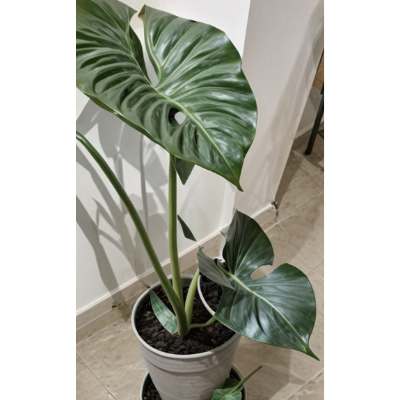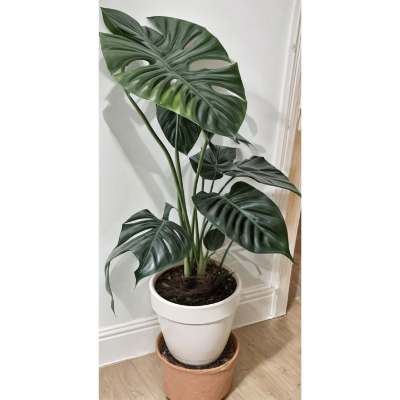The bending of Elephant Ear stems can be attributed to various factors such as inadequate support, insufficient care, and the weight of their massive leaves. To prevent this, we must strengthen the stems, provide the necessary support, and practice proper maintenance techniques.
If you’re a gardener, you’d know that the fight to keep your plants healthy and vibrant is a battle worth waging. Among the various challenges gardeners face, the issue of elephant ear stems bending is not uncommon. These lush, tropical plants are known for their large, striking leaves, but their sheer size can sometimes lead to bending or drooping stems. Fear not, fellow gardener, for in this article, we’ll delve into the art of caring for elephant ear plants and explore ways to prevent, strengthen, and support their stems. So, let’s embark on this horticultural adventure and keep your elephant ear stems standing tall and proud.
Elephant Ear Plant Care
Elephant ear plants, scientifically known as Colocasia or Alocasia, are a true wonder of nature. Their enormous, heart-shaped leaves add a touch of the exotic to any garden or indoor space. To keep these magnificent plants thriving, proper care is crucial.
The first step in elephant ear plant care is to provide them with the right growing conditions. These plants thrive in well-draining soil, rich in organic matter. Plant them in a location that receives partial shade to full shade, as they are not fans of direct sunlight. Consistent moisture is essential, as elephant ears enjoy a humid environment. This can be achieved by regular watering, ensuring the soil remains evenly moist but not waterlogged.
Fertilizing is important for their growth. Use a balanced, water-soluble fertilizer every 2-4 weeks during the growing season (spring and summer). Also, consider mulching to help retain soil moisture and suppress weeds.
Preventing Elephant Ear Stems from Bending

Now, let’s get to the heart of the matter: preventing those elephant ear stems from bending under the weight of their impressive leaves. The issue of bending stems often arises due to the size and weight of the leaves, which can be a bit overwhelming for the plant.
To tackle this problem, make sure you are not overwatering your elephant ear plant. Excessive water can lead to root rot, which weakens the plant and makes it more prone to bending. Ensure that the soil is well-draining to avoid waterlogged conditions.
Proper spacing is also key. When planting, provide enough room between individual plants to allow for proper air circulation. This will help prevent the leaves from becoming too dense and heavy for the stems to support.
Consider using a layer of organic mulch around the base of your elephant ear plants. Mulch helps regulate soil temperature, maintain moisture, and prevents the soil from drying out too quickly. As a result, your plant will have a stronger root system and more robust stems.
Strengthening Elephant Ear Stems
Strengthening the stems of your elephant ear plants is essential to prevent them from bending or drooping. The strength of the stem largely depends on the overall health of the plant. Here are some additional steps you can take to ensure sturdy stems:
- Pruning: Regularly trim any damaged or dead leaves to divert the plant’s energy to healthier growth. This can also reduce the weight on the stems.
- Feeding: As mentioned earlier, proper fertilization can promote strong and vigorous growth. Adequate nutrients help the stems stay firm and upright.
- Soil amendment: Mix in some well-rotted compost or organic matter into the soil to improve its structure and nutrient content, benefiting the overall health of the plant.
- Support stakes: If your elephant ear stems are already bending, use support stakes to gently prop them up. Be sure to tie the stems lightly to avoid damaging them further.
Providing Support for Elephant Ear Stems

In the world of gardening, providing support to your plants is like being a good friend – always there when needed. When it comes to elephant ear stems, a little help can go a long way in keeping them upright and proud.
One of the most effective methods for providing support is to use stakes. Wooden or bamboo stakes can be placed in the ground near the plant and tied gently to the stems. This prevents them from bending and allows the plant to grow vertically.
If you prefer a more aesthetic approach, decorative trellises or plant supports can be used. These not only provide support but also add an element of design to your garden. Place these supports around the elephant ear plants and guide the stems as they grow.
Elephant Ear Stem Maintenance
Maintenance is the cornerstone of keeping your elephant ear stems strong and healthy. It involves a series of regular tasks to ensure the plant’s well-being.
Pruning is a vital aspect of maintenance. Remove any damaged, yellowing, or dead leaves as soon as you spot them. This not only keeps your plant looking tidy but also redirects nutrients to the healthy parts of the plant.
Maintain consistent watering practices, avoiding both overwatering and allowing the soil to dry out completely. Elephant ear plants prefer consistently moist soil but not waterlogged conditions. Monitor the soil moisture levels and adjust your watering accordingly.
Fertilize your plant as recommended, but be cautious not to over-fertilize, as this can lead to excessive growth that might put extra strain on the stems.
Protecting Elephant Ear Stems from Damage
Sometimes, elephant ear stems bend or break due to external factors like strong winds or accidental damage. To protect your plant from such harm, consider the following:
- Windbreaks: Plant windbreaks or use natural features in your garden to shield your elephant ear plants from strong winds.
- Protective barriers: If you’re aware of a particular area that’s prone to accidental damage, consider placing barriers to deter any potential harm.
- Regular inspection: Keep an eye on your plants, especially during periods of adverse weather, and take prompt action if you notice any damage.
Techniques to Keep Elephant Ear Stems Upright
There are several techniques to ensure your elephant ear stems remain upright, showcasing the plant’s full beauty. Let’s explore some of them:
Table: Techniques for Keeping Elephant Ear Stems Upright
| Technique | Description |
|---|---|
| Staking | Using stakes to support the stems. |
| Trellises | Decorative trellises provide support and style. |
| Mulching | Helps regulate soil moisture and temperature. |
| Pruning | Removing dead or damaged leaves redirects energy. |
| Proper watering | Maintaining consistent moisture levels in the soil. |
| Fertilizing | Providing essential nutrients for growth. |
By employing these techniques, you’ll not only prevent bending but also enhance the overall health and appearance of your elephant ear plants.
Supporting Elephant Ear Stalks
The large, attractive leaves of elephant ear plants can be quite a load for their stalks to bear. To ensure the stalks remain strong and upright, you can offer support in various ways.
Gentle ties or clips can be used to secure the leaves to the stalks. Be careful not to tie too tightly, as this can damage the plant. The goal is to provide stability without constricting growth.
Additionally, some gardeners opt to place stakes or rods around the plant and then tie the stalks gently to them. This method offers consistent support and keeps the stalks from bending under the weight of the leaves.
Elephant Ear Stem Training
Another effective way to maintain upright elephant ear stems is through training. Training the plant means gently guiding its growth to encourage an upright posture. This process is quite simple:
- Identify the direction you want the stem to grow.
- Use soft ties or twine to secure the stem to a stake or trellis, gently bending it in the desired direction.
- Monitor the plant as it grows, adjusting the ties as needed.
Training is a long-term solution that not only prevents bending but also helps shape your plant in a visually appealing manner.
Preventing Bending in Elephant Ear Stems
Bending in elephant ear stems can be frustrating, but with the right care and attention, it can be prevented. In summary, make sure you follow these key steps:
- Provide proper care, including the right soil, moisture, and feeding.
- Avoid overwatering and ensure good drainage.
- Use stakes, trellises, or other supports when necessary.
- Regularly prune and maintain your plant.
- Protect your elephant ear from external damage.
By following these guidelines, you can enjoy the lush beauty of your elephant ear plants without worrying about their stems bending or drooping.
Related Questions
Elephant Ear Stems Bending After Repotting
Repotting your elephant ear plants can be a delicate operation. To prevent bending stems after repotting, ensure that the new pot is adequately sized and maintain consistent care.
Elephant Ear Stems Bending Reddit
Gardening communities on Reddit can be a great resource for advice. If you’re experiencing bending stems, consider sharing your situation on a gardening subreddit to get valuable tips from experienced gardeners.
Elephant Ear Leaves Drooping and Turning Yellow
Drooping and yellowing leaves are often a sign of overwatering or poor drainage. Adjust your watering habits and ensure the soil drains well to address this issue.
How to Stake Elephant Ears
Staking elephant ear plants involves using stakes or other support structures to keep their stems upright. This helps maintain the plant’s aesthetic appeal and overall health.
Should I Cut Off Damaged Elephant Ear Leaves
Removing damaged or yellowing leaves is recommended, as it diverts the plant’s energy to healthier growth. Use sharp, clean scissors or pruning shears to snip off damaged leaves at the base. Know how to Propagating Elephant Ear Plant – Simple & Easy Method.
Elephant Ear Plant Broken Stem
If you accidentally break a stem, don’t worry. You can often propagate new plants from the broken sections. Place the broken stem in water or soil, and it may develop roots and grow into a new plant. Know full guide on Elephant Ear Plant Broken Stem – Simple Fix That You Should Apply.
If You Cut Elephant Ears, Will They Grow Back?
Elephant ear plants are resilient. If you prune them properly, they will often regrow and produce new leaves, leading to a fuller, healthier plant.
Elephant Ear Leaves Too Heavy
If your elephant ear leaves are too heavy and causing the stems to bend, employ the techniques discussed in this article, such as staking and training, to keep them upright and vibrant.
Also Read :
Elephant Ear Plant Brown Spots: 5 Causes, Fix & Care Directions
Tiny Bugs on Elephant Ear Plant – How You Get Rid of it
Fungal Leaf Blight Elephant Ear Treatment (& White Spots Fix)
How Often Do You Water Elephant Ears? (CARE)
Elephant Ear Plant Drooping – Why & How to Save(13 Reasons)
